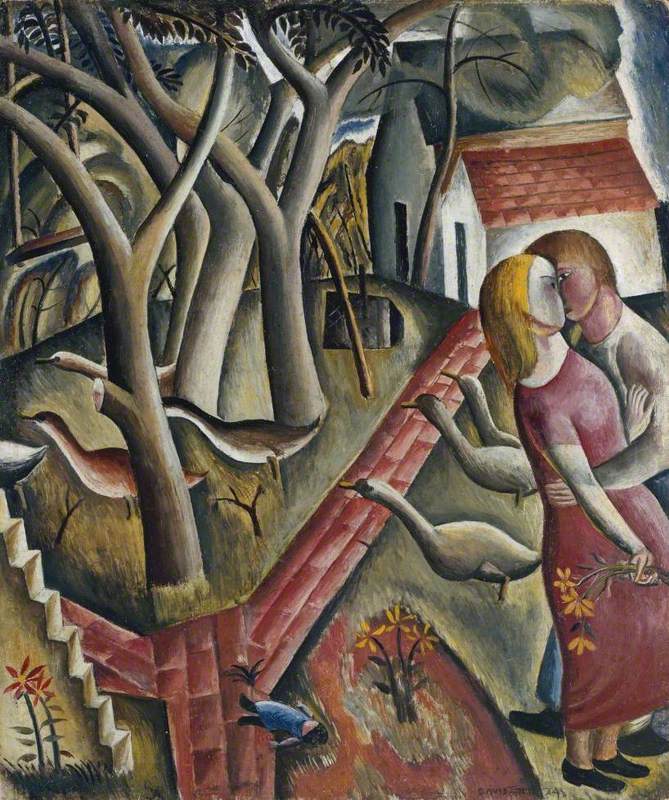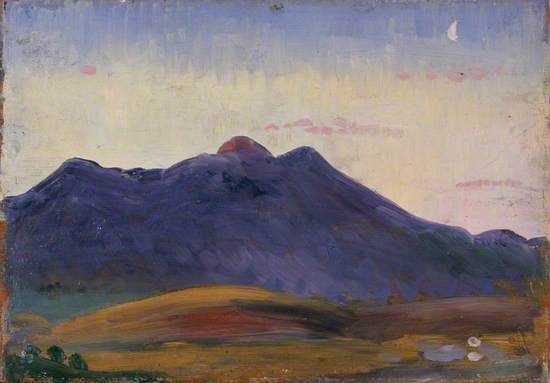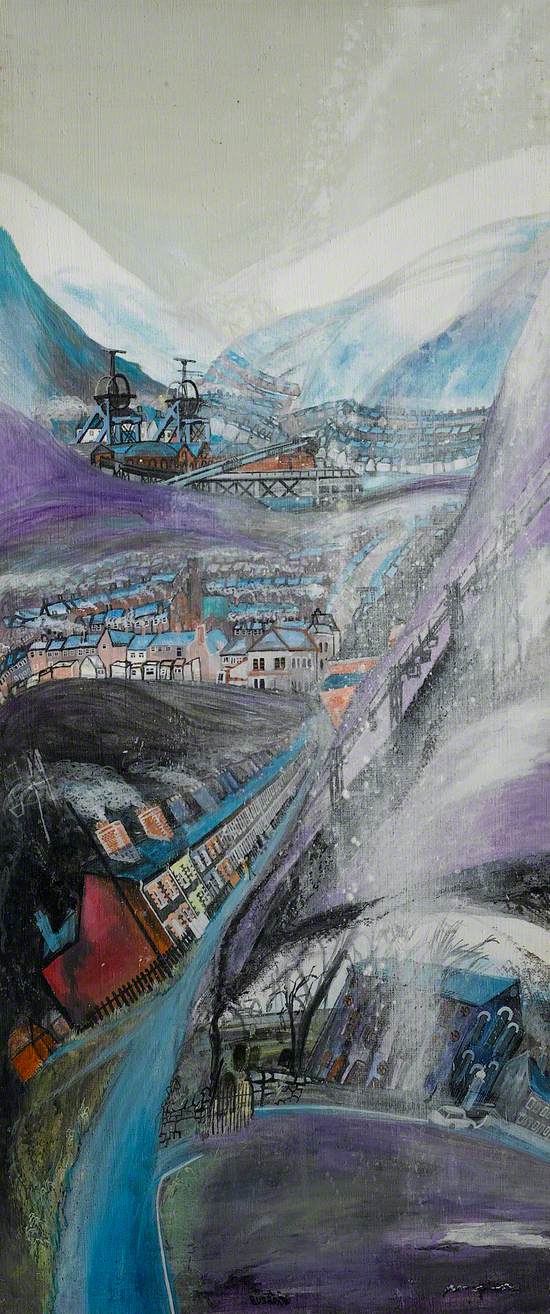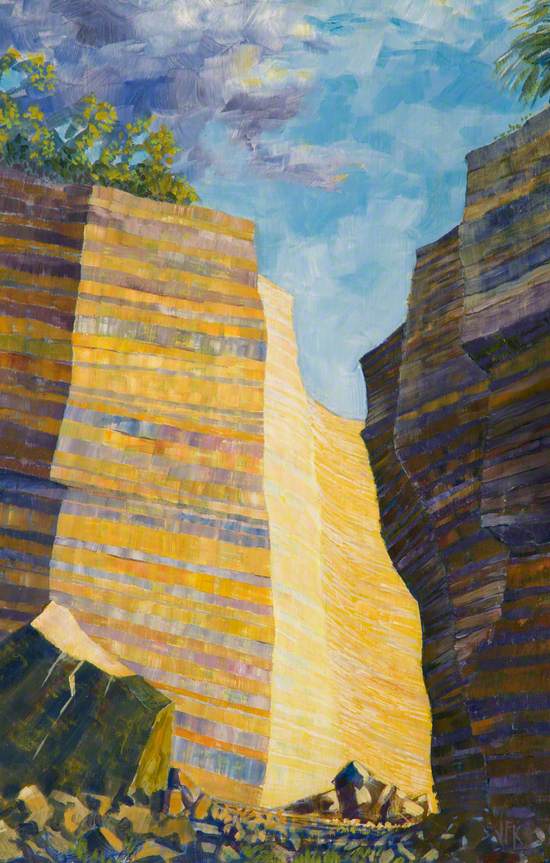The recent UK Covid Lockdown meant that I no longer saw the mountains of Eryri on a daily basis. I really did miss looking at them from Ynys Môn and assessing the likely weather for the day.
At the same time I was home working for the UK Joint Nature Conservation Committee. This included providing advice to Environment Platform Wales on their annual evidence conference. This year the theme is "Resilience in the Welsh Uplands - An Evidence Perspective" https://epwales.org.uk/environment-evidence
The wide ranging interpretation of the conference title has inspired this personal selection of art to provide an artistic perspective on resilience.
Habitats
The Welsh Uplands support a diversity of semi-natural habitats including acid grassland, heathland, rivers and lakes, and blanket bog but broadleaved woodland is extremely restricted to gullies, rocky ledges and other shelterd places.
Enid Chiverton (active 1975–1979)
Oil on board
H 48 x W 59 cm
Williamson Art Gallery & Museum
.
Farming
In Williams' depictions of the rocky Welsh Uplands, the solitary images of stooped farmers, with their walking sticks, are invariably accompanied by lively sheepdogs.
Kyffin Williams (1918–2006)
Oil on canvas
H 60.7 x W 91 cm
Llyfrgell Genedlaethol Cymru / The National Library of Wales
Sheep
It is estimated that there are more than 10 million sheep in Wales. Their grazing activity has had a major impact on upland environments and the nature of the landscapes.
William Shiels (1783–1857)
Oil on canvas
H 109 x W 73.5 cm
Amgueddfa Cymru – National Museum Wales
Wildlife
The evocative sound of a curlew is part of the upland soundscape in Wales. However the breeding population is in decline so conservation and monitoring projects are underway.
Charles Frederick Tunnicliffe (1901–1979)
Pensil, inc, dyfrlliw a gouache ar bapur / pencil, ink, watercolour & gouache on paper
H 47 x W 59 cm
Oriel Môn
Trains
Today the great little steam trains of Wales are a major tourist attraction but many were developed to facilitate the exploitation of the natural resources of Wales, such as slate.
Anna Todd (b.1964)
Acrylic on board
H 109 x W 168 cm
Cardiff and Vale University Health Board
.
Roads
Many explorations of wild Wales require a road trip through the mountains along some historic routes and sometimes challenging driving conditions.
Will Evans (1888–1957)
Oil on canvas
H 61.2 x W 66 cm
Glynn Vivian Art Gallery
Slate
The exploitation of the natural resources of the Welsh Uplands has created landscapes of international social and cultural importance. Bethesda or Penrhyn Quarry was once the world's largest slate quarry.
Metal
Metals have been mined in the mountains of Wales since the Roman invasion and probably even before then. This activity has produced colourful lunar landscapes and seriously polluted rivers, turning them red, acid and devoid of life.
Karel Lek (1929–2020)
Oil on canvas
H 50 x W 75.6 cm
Llyfrgell Genedlaethol Cymru / The National Library of Wales
Women
This painting was one of a series made by Dorothie Field in response to the Aberfan disaster that took place on 21 October 1966. The catastrophic collapse of a colliery spoil tip down the mountain side above the village killed 116 children and 28 adults. The mothers of those children set up their own support group which still meets today.
Dorothie Field (1915–1994)
Oil on board
H 63 x W 106 cm
National Coal Mining Museum for England
Artistic Inspiration
"....her whole small being was lit with pure delight in the beauty and mystery of those aspects of the created world she loved, most especially the mountains of Eryri, the dramatic landscape of Snowdonia..."
Brenda Chamberlain (1912–1971)
Oil on canvas
H 30.4 x W 30.4 cm
Amgueddfa Cymru – National Museum Wales
Peace
Christopher Williams, a pacifist, witnessed the trenches of World War 1 and produced paintings which captured the horror and sacrifice. He also clearly found peace in his representation of women in the landscape and nature.
Christopher Williams (1873–1934)
Oil on millboard
H 53.2 x W 63.2 cm
Amgueddfa Cymru – National Museum Wales
Colour
Although seriously ill with tuberculosis James Dickinson Innes walked the Welsh uplands producing intensely colourful and lyrical landscapes. He considered the Mynydd Arenig his "sacred mountain".
James Dickson Innes (1887–1914)
Oil on panel
H 23 x W 33 cm
Amgueddfa Cymru – National Museum Wales
Communities
Community spirit and resilience are key characteristics of the South Wales valleys communities who for generations have worked hard in challenging industrial landscapes and social conditions.
Barbara Mary Russon (1930–2007)
Oil on canvas
H 117.9 x W 50.5 cm
Herbert Art Gallery & Museum
Identity
Commissioned to commemorate the flooding of the Tryweryn valley and the loss of the upland Welsh speaking village of Capel Celyn. The faces embedded in the feathers combine mixed emotions of anger, fear and protest, with the hopeful shape of the rising water bird.
John Meirion Morris (1936–2020)
Bronze & slate
H 79 x W 51 x D 23 cm
Llyfrgell Genedlaethol Cymru / The National Library of Wales
Environment
The development of abstract art in Wales was concurrent with a growing awareness of environmental issues.
Ernest Zobole (1927–1999)
Oil on hardboard
H 183 x W 122 cm
University of South Wales Art Collection Museum
Geodiversity
Geology is part of our abiotic natural world and conserving its diversity is a core part of the nature conservation mission in Wales and the UK. Quarries often illustrate and provide access to scientifically important stratigraphic sequences of rock.
John Kavanagh (1943–1998)
Oil on board
H 54.5 x W 38 cm
Grosvenor Museum
.
Fish
Salmon and trout are the iconic fish of Welsh river ecosystems, spawning in headwater streams. Egg hatching is temperature dependent making them vulnerable to climate change.
Delia Portsmouth (b.c.1916)
Oil on board
H 23.7 x W 39.4 cm
Llyfrgell Genedlaethol Cymru / The National Library of Wales
Lakes
Many of the lakes of Wales were impacted by the effects of "Acid Rain" in the 1970-80s, including the loss of native trout populations. It has been suggested that base rich rocks in the catchment of Llyn Idwal protected it from acidification. More recently there has been positive evidence of recovery at several lakes following reductions in air pollution.
Benjamin Williams Leader (1831–1923)
Oil on panel
H 38 x W 59 cm
University of Dundee Fine Art Collections
.

Waterfalls
Nothing stops a river even if it must tumble and fall.
David Jones (1895–1974)
Watercolour on paper
H 58 x W 41 cm
Royal Watercolour Society
Nature Conservation
Blind in old age Evan Roberts (quarryman, botanist, Warden of Cwm Idwal) looks upwards in appreciation of the plants and habitats he cared for in the Welsh Uplands.
Kyffin Williams (1918–2006)
Olew ar gynfas / oil on canvas
H 72 x W 72 cm
Oriel Môn
Explore artists in this Curation
View all 19-
 Christopher Williams (1873–1934)
Christopher Williams (1873–1934) -
 Ernest Zobole (1927–1999)
Ernest Zobole (1927–1999) -
 Dorothie Field (1915–1994)
Dorothie Field (1915–1994) -
 Benjamin Williams Leader (1831–1923)
Benjamin Williams Leader (1831–1923) -
 Brenda Chamberlain (1912–1971)
Brenda Chamberlain (1912–1971) -
 Anna Todd (b.1964)
Anna Todd (b.1964) -
 Kyffin Williams (1918–2006)
Kyffin Williams (1918–2006) -
 David Jones (1895–1974)
David Jones (1895–1974) -
 Will Evans (1888–1957)
Will Evans (1888–1957) -
 Barbara Mary Russon (1930–2007)
Barbara Mary Russon (1930–2007) - View all 19


















